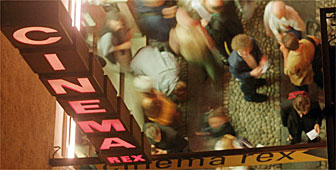Locarno ends on a high note

At the end of the 55th International film festival, Locarno has joined the big league.
Late last year, the International Federation of Film Producers’ Associations officially acknowledged that Locarno had come of age: no longer was it a festival specialising in “young” and new films (rather an ambiguous definition in any case), but a full-scale festival of general interest.
Helping the festival to achieve this new status was a budget of SFr8 million (including SFr1.2 million from the central government).
Catering for all tastes
The verdict of David Streiff, director of the Federal Office for Culture, who was the festival’s director from 1982 to 1992 is that: “Cannes is for the professionals, Venice takes pride in its ‘chic’, and Locarno is a festival for everyone.”
Streiff feels that this annual ten-day total-immersion course in cinematographic culture is unique.
“If you like, you can spend 20 hours a day in a cinema auditorium, while the less committed can combine the festival with a holiday in a region of great natural beauty. The formula works perfectly: so much so that new auditoria are being built to meet the growing demand from film-lovers.”
Glut of films
But is there risk that the glut of films is robbing Locarno of its character, turning into just another showcase for “big” film?
“I would prefer a more limited selection,” admits Streiff, who is careful not to criticise the festival’s management. “But we live in an age when people demand the widest possible choice. You only need look at the supermarket shelves to realise that.”
The festival organisers have been sensitive to the needs of both the general public and dedicated film buffs, for instance showing “popular” films in the Piazza Grande (the town’s main square).
But for Streiff and others who remember what Locarno used to be, there is some nostalgia for the days when everyone followed the same schedule.
“The audience no longer feels they are sharing the same experience,” he says, but admits again that, even as director of Locarno, he was unable to prevent the exponential growth of the festival.
Yet nothing can detract from the fascination of a dark projection room. “It is something that has always amazed me: seeing the Fevi auditorium packed with spectators – especially young, really devoted film-goers – even on the most sunny days,” recalls Streiff.
At night the audience tended to be mainly holiday makers, but they too are “…proof is that last year the prize for the most widely acclaimed film went to an Indian production lasting four hours!”
Doing business
Locarno is not just a Mecca for tourists and film buffs, it is also a meeting place for producers and distributors. In recent years, an experimental area – the “Industry Office” – has been set up to facilitate the business side of things.
What does Streiff think? “I don’t think Locarno will ever be able to compete with the really big markets, like Cannes, but it is right to encourage art films, and filmmakers from emerging countries, by providing meeting facilities.”
Streiff adds that, for a long time now, Swiss producers and cinema-owners have been meeting at Locarno to discuss their scheduling for the following season.
And though Locarno has assumed a new commercial role, it does not seem to have lost its original qualities: popular participation, cultural debate in the shade of the palm trees beside Lake Maggiore, and the chance to gorge on new films.
By Raffaella Rossello and Daniele Papacella

In compliance with the JTI standards
More: SWI swissinfo.ch certified by the Journalism Trust Initiative








You can find an overview of ongoing debates with our journalists here . Please join us!
If you want to start a conversation about a topic raised in this article or want to report factual errors, email us at english@swissinfo.ch.